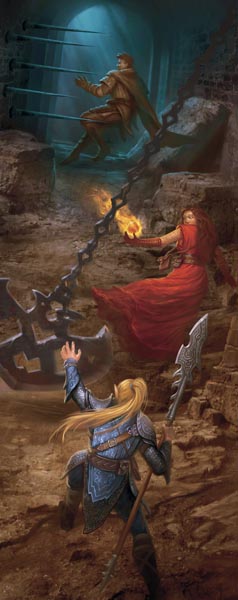
![]() I love D&D podcasts – especially ones that discuss game design and game balance, and especially ones that include actual D&D writers and game designers and their takes and tips on various game aspects. You often get something more energetic and “alive” out of the podcast format that goes above and beyond a written article.
I love D&D podcasts – especially ones that discuss game design and game balance, and especially ones that include actual D&D writers and game designers and their takes and tips on various game aspects. You often get something more energetic and “alive” out of the podcast format that goes above and beyond a written article.
Hearing an engaged conversation about the design and balance of game elements in D&D is a great source of inspiration for your own D&D game ideas and improvements. In short, these lively dialogues make you a better DM and player. As such, I’m a big fan of the Critical Hits podcasts. This week, Mike Shea of Sly Flourish interviewed D&D designer Chris Sims.
Here are a few of my big takeaways from this week’s Critical Hits podcast, related to creature (PC and monster) motivations and the encounter environment. Do yourself a huge favor and find a way to fit in an occasional listening session into your day once in a while.
The Tiny Encounter
The two goblin guards. The goal or motivation for the PCs becomes how to overcome them quickly or in a way that doesn’t have those guards alert the rest of the tower to intruders. Chris articulates well what makes this encounter unique: the pre-encounter planning and strategy interaction and conversation among PCs becomes the meat of it, essentially before the encounter. Also a nice change of pace from “boom, combat, roll initiative” with little to no opportunity for strategic and tactical discussion beforehand.
Robert J. Schwalb has blogged about this type of more “old school” encounter before, where a full tactical encounter layout and presentation is not needed in a published adventure, for example. Chris Sims agrees there’s plenty of room for this type of encounter, despite published adventures typically encouraging major tactical set piece encounters.
While immersive, the tiny encounter definitely won’t always fit the standard XP budget rules. In this way, the tiny encounter feels like a hybrid skill challenge and standard encounter to me, with multiple potential outcomes on encounter size and difficulty being what’s at stake. As someone who passionately promotes a balanced D&D experience between gameplay and story, I’m very much on board with the tiny encounter.
Environmental Effects You Can Fight
Flat environmental damage may make the encounter more cinematic, dramatic and deadly (which is almost always a good thing), but sometimes it’s not very engaging. In the podcast, Mike and Chris talk about how a simple skill check, such as Endurance, might influence how much damage you take instead.
For example, in the Primal Frostfell campaign I run, one encounter included pulses of necrotic energy that emanated from a crystal atop a tower controlled by tanarukk. Instead of a mounting 10/15/20 ongoing damage pulse at the start of each round, I could have additionally asked for Endurance checks. Success against X DC changes the actual damage taken by the character. Perhaps Hard DC success = 10 ongoing, MDC = 15, and Easy = 20, Failed Easy = 25, similar to disease stages and endurance checks.
This way, certain aspects of your character makes more of a difference, and a quick, relevant roll gets you more involved as a player character, hoping to roll well to “fight” the encounter element or effect. Should every environmental effect be something characters can influence with a roll? That is certainly up to you to experiment with and decide.
Minion Traps
Chris Sims mentioned traps that cover multiples areas or squares in an encounter, and having multiple spots, areas, items, or features of an area count as 1/x’th of a trap, or a minion trap, with each successful Thievery or relevant check neutralizing that portion of the trap instead of one trap with multiple skill checks. The spear gauntlet and similar traps make excellent candidates for this approach.
Mike Shea – who has long said he feels traps and hazards are clunky and all-or-nothing in actual play (and I tend to agree) – actually perked up at this idea. In fact, it’s quite brilliant. Once again, like the aforementioned environmental effects, we see a hybridization of simple skill challenge elements and a “monster,” encouraging more immersive and involved gameplay.
As someone who generally dislikes full-blown skill challenges (often too gamey, time-consuming, or not engaging enough), I see the minion trap as a great way to include a skill component right alongside the classic and unusual “monster” known as the D&D trap or hazard. Time to dust off and “re-imagine” some of your favorite traps and hazards, isn’t it?
[…] as Story: Tiny Encounters by Kilsek on August 5, 2011 What makes the tiny encounter unique? It’s not about the numbers or even tactics, so much as the strategy or potential […]
[…] even more at Leonine Roar: Global Encounter Elements, Encounter Design: Podcast Tips, What’s Your Poison?, True Encounter Difficulty: Lethality vs. Resource Management, True […]